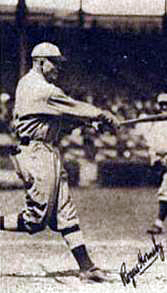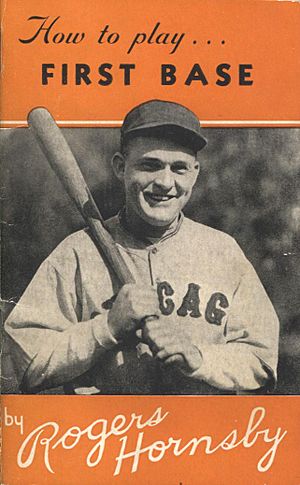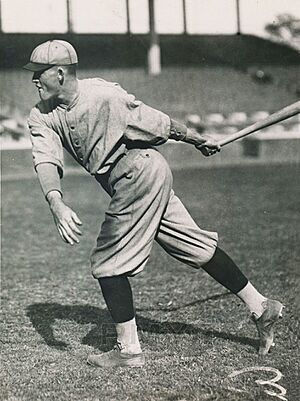Rogers Hornsby facts for kids
Quick facts for kids Rogers Hornsby |
|||
|---|---|---|---|
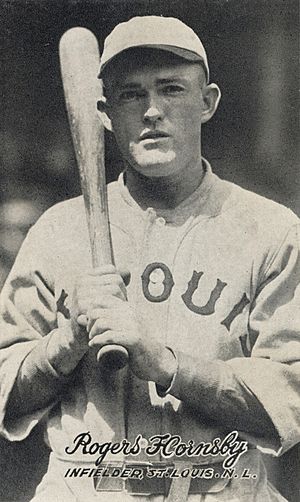 |
|||
| Second baseman / Manager | |||
| Born: April 27, 1896 Winters, Texas, U.S. |
|||
| Died: January 5, 1963 (aged 66) Chicago, Illinois, U.S. |
|||
|
|||
| debut | |||
| September 10, 1915, for the St. Louis Cardinals | |||
| Last appearance | |||
| July 20, 1937, for the St. Louis Browns | |||
| MLB statistics | |||
| Batting average | .358 | ||
| Hits | 2,930 | ||
| Home runs | 301 | ||
| Runs batted in | 1,584 | ||
| Managerial record | 701–812 | ||
| Winning % | .463 | ||
| Teams | |||
As player
As manager
|
|||
| Career highlights and awards | |||
|
|||
| Induction | 1942 | ||
| Vote | 78.1% (fifth ballot) | ||
Rogers Hornsby Sr. (April 27, 1896 – January 5, 1963), known as "The Rajah", was an American baseball player, manager, and coach. He played for 23 seasons in Major League Baseball (MLB). He is remembered as one of the greatest hitters in baseball history.
Hornsby played for several teams, including the St. Louis Cardinals (1915–1926, 1933), New York Giants (1927), Boston Braves (1928), Chicago Cubs (1929–1932), and St. Louis Browns (1933–1937). He won the National League (NL)'s Most Valuable Player (MVP) award twice. He also helped his team win one World Series championship.
Born in Winters, Texas, Hornsby grew up in Fort Worth, Texas. He started his major league career with the St. Louis Cardinals in 1915. He stayed with them for 12 seasons. During this time, he won his first MVP Award. The Cardinals also won the 1926 World Series with him. After playing for other teams, he returned to the Cardinals in 1933. He later played for the St. Louis Browns until 1937. From 1925 to 1937, Hornsby was also a player-manager for some of his teams. After he stopped playing, he managed the Browns and the Cincinnati Reds.
Hornsby is famous for his amazing hitting skills. His career batting average of .358 is the second highest in MLB history. Only Ty Cobb had a higher average (.366). Hornsby also won two Triple Crowns. He hit over .400 three times in his career. In 1922, he was the only player to hit 40 home runs and bat .400 in the same year. His .424 batting average in 1924 is a record no player has matched since. He was chosen for the National Baseball Hall of Fame in 1942.
Contents
Early Life and Baseball Beginnings
Hornsby was born in Winters, Texas. He was the youngest of six children. His father passed away when Rogers was two years old. When he was six, his family moved to Fort Worth, Texas. This move helped his older brothers find jobs to support the family.
Rogers started playing baseball at a very young age. He once said he couldn't remember a time before he had a baseball in his hand. At 10, he worked as a messenger boy for a meat packing plant. He also played on their baseball team. By 15, Hornsby was playing for several semi-professional teams. He played baseball for North Side High School until 10th grade. Then, he left school to work full-time.
Minor League Journey
In 1914, Hornsby's older brother, Everett, helped him get a tryout. He tried out for the Texas League's Dallas Steers. He joined the team but was released quickly. Then, he signed with the Hugo Scouts for $75 a month. The team soon closed. Hornsby's contract was sold to the Denison Railroaders for $125. In 1914, he batted .232 and made 45 errors.
In 1915, the Denison team became the Railroaders. They joined the Western Association. Hornsby's salary increased to $90 a month. His batting average improved to .277. He still made 58 errors. Despite this, his play helped the Railroaders win the Western Association pennant. A writer from The Sporting News said Hornsby showed potential for the major leagues.
St. Louis Cardinals: Early Years
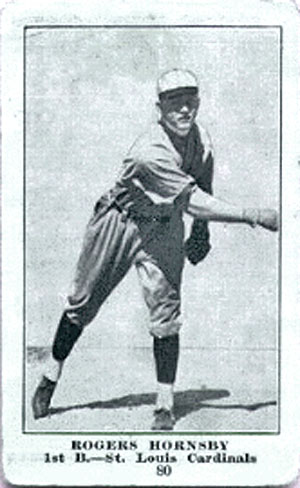
Joining the Cardinals in 1915
Rogers Hornsby caught the eye of the St. Louis Cardinals in 1915. This happened during a practice game against the Railroaders. The Cardinals' manager, Miller Huggins, was looking for new players. In September, the Cardinals bought Hornsby's contract. He joined their major league team, even though he had only played in lower leagues. Hornsby's first game was on September 10. He played shortstop in a loss to the Cincinnati Reds. He got his first hit a day later. Hornsby finished the season with a .246 average. He was only 19 years old.
Becoming a Star Player
In 1916, Hornsby became the starting shortstop for the Cardinals. He had a great spring training. He helped the Cardinals win their first game against the Pittsburgh Pirates. On May 14, he hit his first major league home run. He played different infield positions. Later in the season, he played mostly third base. He finished 1916 with a .313 average. This was the fourth best in the NL. He also had 15 triples.
Hornsby moved back to shortstop in 1917. His batting improved even more. His .327 batting average was second in the league. He also led the league in triples (17). He led in total bases (253) and slugging percentage (.484) too.
In 1918, many baseball players joined the military for World War I. Hornsby was allowed to stay because he supported his family. The Cardinals got a new manager, Jack Hendricks. Hornsby did not like Hendricks. His batting average went down to .281. He was still a league leader in triples and slugging percentage. After the season, Hornsby said he would not play for Hendricks again. Hendricks was fired and Branch Rickey became the new manager.
In 1919, Rickey tried to make Hornsby a second baseman. But Hornsby played third base for most of the year. His batting average improved by June. He finished the season with a .318 average. This was the second highest in the league. He was also second in total bases and runs batted in.
Leading the League in Hitting
In 1920, Rickey moved Hornsby to second base for good. He started the year with a 14-game hitting streak. He finished the season with his first of seven batting titles. He hit .370. He also led the league in on-base percentage (.431), slugging percentage (.559), hits (218), total bases (329), doubles (44), and RBIs (94).
The "live-ball era" began, which meant more powerful hitting. This helped Hornsby hit with more power in 1921. He hit .397. His 21 home runs were more than double his previous best. He also led the league in on-base percentage (.458), slugging percentage (.639), runs scored (131), RBIs (126), doubles (44), and triples (18).
By 1922, Hornsby was a big star. He asked for a three-year contract for $25,000 per season. He agreed to $18,500, making him the highest-paid player at that time. On August 5, Hornsby set a new NL record with his 28th home run. He also had a 33-game hitting streak. Hornsby set National League records with 42 home runs, 250 hits, and a .722 slugging percentage. His .401 batting average was the highest in the NL since 1897. He won his first Triple Crown that year. He also led the league in RBIs (152), on-base percentage (.459), doubles (46), and runs scored (141). His 450 total bases in 1922 are still an NL record.
In 1923, Hornsby hurt his left knee. He returned after 10 days, but the injury continued to bother him. He still won his fourth straight NL batting title with a .384 average. He also led in on-base percentage (.459) and slugging percentage (.627).
Hornsby's average went up to .424 in 1924. This is the fourth-highest batting average in a single MLB season. He led the league with 89 walks. This gave him a .507 on-base percentage, an NL record for over 75 years. His .696 slugging percentage also led the league. He had 121 runs scored, 227 hits, and 43 doubles. He also hit 25 home runs. The NL brought back its Most Valuable Player (MVP) award that year. Even though Hornsby was expected to win, the award went to Dazzy Vance. In 1962, Hornsby was given an award that recognized him as the 1924 MVP.
Player-Manager and World Series Champion
In 1925, the Cardinals' owner, Sam Breadon, wanted to replace manager Rickey. Hornsby agreed to become the Cardinals' player-manager. Hornsby finished the year with his second Triple Crown. He had a .403 batting average, 39 home runs, and 143 RBIs. No National Leaguer has matched his 1925 batting average since. He won the MVP Award that year. His .756 slugging percentage and 1.245 on-base plus slugging set NL records that lasted until 2001. The Cardinals finished in fourth place in 1925.
Hornsby had a slightly less strong year in 1926, hitting .317 with 11 home runs. But St. Louis won its first NL pennant. In the 1926 World Series, the Cardinals beat the Yankees in seven games. Hornsby tagged out Babe Ruth to end the Series. This made the Cardinals world champions. It was the only time Hornsby would be a world champion. In the Series, Hornsby batted .250. Years later, Hornsby said tagging out Ruth was the biggest thrill of his career.
After the season, Hornsby wanted a new contract for $50,000 per year. The Cardinals traded him to the New York Giants for Frankie Frisch and Jimmy Ring. The trade was delayed because Hornsby owned stock in the Cardinals. He sold his shares, and then officially became a Giant.
Playing for Other Teams
New York Giants and Boston Braves
Hornsby had a good season in 1927 with the New York Giants. He hit .361. He also led the league in runs scored (133), walks (86), and on-base percentage (.448). He was a player-coach and managed the Giants for part of the year. The Giants finished in third place. Hornsby was traded to the Boston Braves after the season.
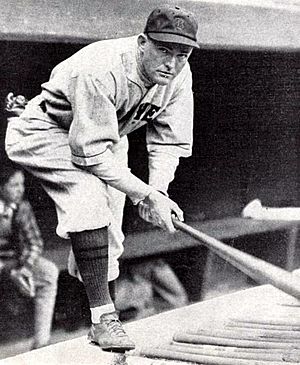
In 1928, with the Boston Braves, Hornsby was again the league's best hitter. He won his seventh batting title with a .387 average. He also led the league in on-base percentage (.498), slugging percentage (.632), and walks (107). He became the manager of the Braves one month into the season. The Braves lost 103 games and finished seventh. The Braves were having money problems. The Chicago Cubs offered $200,000 and five players for Hornsby. The Braves accepted the offer.
Chicago Cubs Success
Hornsby hit .380 for Chicago in 1929. He also had 39 home runs and a league-leading .679 slugging percentage. His 156 runs scored led all of MLB and is still a Cubs record. His .380 batting average is the highest for a Cub since 1895. He won another MVP award. The Cubs won the NL pennant. However, they lost the 1929 World Series to the Philadelphia Athletics in five games. Hornsby batted .238 in the Series.
In 1930, Hornsby broke his ankle. He returned later in the season. With four games left, the Cubs fired manager Joe McCarthy. Hornsby took over as manager. He finished the year with a .308 batting average.
On April 24, 1931, Hornsby hit three home runs and drove in eight runs. This helped the Cubs win 10–6. He played in 100 games that year. He had 90 RBIs, 37 doubles, and a .331 batting average. He also led the league in on-base percentage (.421) for the ninth time. The team finished third.
In 1932, Hornsby was bothered by foot problems. He played in 19 games, batting .224. On August 2, the Cubs fired Hornsby as manager and released him as a player. First baseman Charlie Grimm took over as manager. The Cubs went to the 1932 World Series. However, the players voted not to give Hornsby a share of the World Series money.
St. Louis Cardinals and Browns: Final Playing Years
Hornsby did not play for the rest of 1932. But the Cardinals signed him again for the 1933 season. He played regularly at second base for a short time. After May 5, the Cardinals used him mostly as a pinch hitter due to foot and leg problems. On July 22, Hornsby got his final NL hit. The Cardinals then released him.
The St. Louis Browns of the American League picked up Hornsby on July 26. They immediately made him player-manager. Hornsby played in 11 games for the Browns. He had three hits, including a home run. The Browns finished in last place. Hornsby also started a baseball school in Hot Springs, Arkansas. He ran it on and off until 1951. He played in 57 games in 1933.
 |
|
| Rogers Hornsby was honored alongside the retired numbers of the St. Louis Cardinals in 1937. |
In 1934, Hornsby played in 24 games, mostly as a pinch hitter. He batted .304 with one home run. The Browns improved to sixth place.
Hornsby played in 10 games in 1935. He finished the year with five hits and a .208 average. The Browns slipped to seventh place. The team had to sell good players to pay bills. This continued during Hornsby's time with the Browns.
In 1936, Hornsby played in only two games. On May 31, his pinch-hit single won a game for the Browns. The Browns finished seventh again. After the season, Hornsby said his team lacked talent.
In 1937, Hornsby played in 20 games. On April 21, he hit the final home run of his career. On July 5, he had the final hit of his career. On July 20, Hornsby played his final game. The next day, he was fired as manager and released as a player by the Browns. Hornsby finished the 1937 season with a .321 batting average. He was the oldest player in the AL that season.
Later Baseball Career
After leaving the Browns, Hornsby continued in baseball. He signed as a player-coach with the Baltimore Orioles in 1938. He then played for and managed the Chattanooga Lookouts. He managed the Orioles again in 1939.
In 1940, he managed the Oklahoma City Indians. He led them to the playoffs. In 1941, he managed the Indians again before leaving. In November, he became the manager of the Fort Worth Cats. They made the playoffs in 1942. The league stopped operations for World War II in 1943.
In 1944, Hornsby signed to play-manage for the Veracruz Blues in Mexico. He won two games by pinch-hitting. His time in Mexico ended quickly due to disagreements.
Hornsby spent 1945 out of baseball. He did radio commentary. He was a hitting instructor for the Chicago White Sox in 1946 and the Cleveland Indians in 1947. He became a TV announcer for Chicago Cubs games in 1949.
Hornsby returned to managing in 1950. He led the Beaumont Roughnecks to the pennant. In 1951, he managed the Seattle Rainiers to a pennant win.
Because of his success, both St. Louis major-league teams offered him contracts. He chose to return to the Browns in 1952. The Browns' owner, Bill Veeck, was the son of a former Cubs president. Hornsby was not popular with the players. He was known for criticizing them.
On June 9, 1952, Hornsby was fired. This happened after a disagreement with Veeck during a game. The Browns players were so happy they gave Veeck a trophy.
A month later, on July 26, Hornsby became the manager of the Cincinnati Reds. The Reds played well under him for the rest of 1952. However, in 1953, the Reds announced he would not return. He resigned with eight games left. He finished his MLB managerial career with 701 wins and 812 losses.
After leaving the Reds, Hornsby coached for the Cubs from 1958 to 1960. He then became a scout and third base coach for the New York Mets in 1962. In 1963, Hornsby passed away from a heart attack. He was buried in Hornsby Bend Cemetery in Texas.
Managerial Record
| Team | Year | Regular season | Postseason | |||||||
|---|---|---|---|---|---|---|---|---|---|---|
| Games | Won | Lost | Win % | Finish | Won | Lost | Win % | Result | ||
| STL | 1925 | 115 | 64 | 51 | .557 | 4th in NL | – | – | – | – |
| STL | 1926 | 154 | 89 | 65 | .578 | 1st in NL | 4 | 3 | .571 | Won World Series (NYY) |
| STL total | 269 | 153 | 116 | .569 | 0 | 0 | – | |||
| NYG | 1927 | 32 | 22 | 10 | .688 | interim | – | – | – | – |
| NYG total | 32 | 22 | 10 | .688 | 0 | 0 | – | |||
| BSN | 1928 | 122 | 39 | 83 | .320 | 7th in NL | – | – | – | – |
| BSN total | 122 | 39 | 83 | .320 | 0 | 0 | – | |||
| CHC | 1930 | 4 | 4 | 0 | 1.000 | 2nd in NL | – | – | – | – |
| CHC | 1931 | 154 | 84 | 70 | .545 | 3rd in NL | – | – | – | – |
| CHC | 1932 | 99 | 53 | 46 | .535 | fired | – | – | – | – |
| CHC total | 257 | 141 | 116 | .549 | 0 | 0 | – | |||
| SLB | 1933 | 52 | 19 | 33 | .365 | 8th in AL | – | – | – | – |
| SLB | 1934 | 152 | 67 | 85 | .441 | 6th in AL | – | – | – | – |
| SLB | 1935 | 152 | 65 | 87 | .428 | 7th in AL | – | – | – | – |
| SLB | 1936 | 152 | 57 | 95 | .375 | 7th in AL | – | – | – | – |
| SLB | 1937 | 77 | 25 | 52 | .325 | fired | – | – | – | – |
| SLB | 1952 | 51 | 22 | 29 | .431 | fired | – | – | – | – |
| SLB total | 636 | 255 | 381 | .401 | 0 | 0 | – | |||
| CIN | 1952 | 51 | 27 | 24 | .529 | 6th in NL | – | – | – | – |
| CIN | 1953 | 146 | 64 | 82 | .438 | resigned | – | – | – | – |
| CIN total | 197 | 91 | 106 | .462 | 0 | 0 | – | |||
| Total | 1513 | 701 | 812 | .463 | 4 | 3 | .571 | |||
Hornsby's Baseball Legacy
Baseball experts believe Hornsby is one of the greatest hitters ever. His lifetime batting average of .358 is second only to Ty Cobb's .366. He won seven batting titles. This is tied or beaten by only five other players. Hornsby led the National League in slugging percentage nine times, which is still a record. He hit more home runs and had a higher batting average than any other NL player in the 1920s. He was the first player to hit 300 home runs while playing mostly in the National League. His 264 home runs as a second baseman was a major league record until 1984.
Hornsby was a consistent hitter both at home and away. His home batting average was .359, and his away average was .358. Ted Williams, another great hitter, said Hornsby was the best hitter for power and average. Frankie Frisch said Hornsby could hit .350 in the dark. Hornsby is the second right-handed batter to hit over .400 three times. He is considered the greatest right-handed hitter in history. He led the National League in batting average, on-base percentage, slugging percentage, and total bases every year from 1920 to 1925.
Rogers Hornsby was so respected as a hitter that an umpire once told a rookie pitcher, "Son, when you pitch a strike, Mr. Hornsby will let you know."
Hornsby was also known for his speed. He was considered the fastest player in the National League in his best years. He used his speed to get extra bases. Between 1916 and 1927, Hornsby had 30 inside-the-park home runs. He led the league with 17 triples in 1917 and 18 triples in 1921. He had 20 triples in 1920.
Hornsby never went to movies or read books. He thought it would hurt his eyesight. He also never smoked or drank. He was known for being a bit difficult to work with. This was a reason he changed teams often later in his career. He often left teams after disagreements with the front office. Many players he managed did not like him. He insisted that others follow his strict lifestyle. Hornsby did bet on horse races. He lost money on these bets. He had to play in the minor leagues into his 40s to make up for lost money.
Hornsby was elected to the National Baseball Hall of Fame in 1942. In 1999, The Sporting News ranked him ninth among Baseball's Greatest Players. He was also named to the Major League Baseball All-Century Team. In 2001, writer Bill James ranked him as the 22nd-greatest player. He was also ranked the third-greatest second baseman. Hornsby is tied for eighth in wins above replacement for position players. He is also recognized on the St. Louis Walk of Fame. In 2014, the Cardinals put Hornsby into the St. Louis Cardinals Hall of Fame Museum.
Personal Life
On September 23, 1918, Hornsby married Sarah Elizabeth Martin. They had a son, Rogers Hornsby, Jr., on November 15, 1920. Rogers Jr. passed away in a plane crash on December 23, 1949.
Hornsby later married Jeanette Pennington Hine on February 28, 1924. They had a son, Billy, on June 2, 1925. Billy played baseball in the minor leagues but did not reach the majors. Hornsby later married Marjorie Bernice Frederick Porter on January 27, 1957. They were together until Hornsby's death in 1963.
See also
 In Spanish: Rogers Hornsby para niños
In Spanish: Rogers Hornsby para niños
- List of St. Louis Cardinals team records
- List of Major League Baseball annual doubles leaders
- List of Major League Baseball doubles records
- List of Major League Baseball hit records
- List of Major League Baseball player-managers
- List of Major League Baseball career triples leaders
- List of Major League Baseball career runs scored leaders
- List of Major League Baseball career runs batted in leaders
- List of Major League Baseball career hits leaders
- List of Major League Baseball career doubles leaders
- List of Major League Baseball career home run leaders


